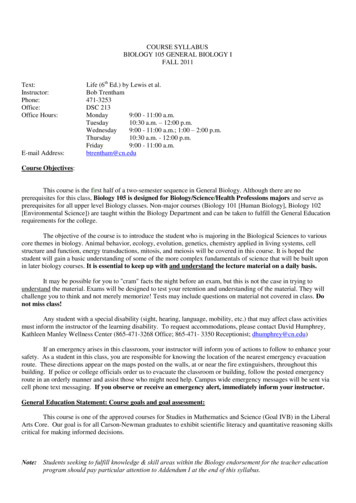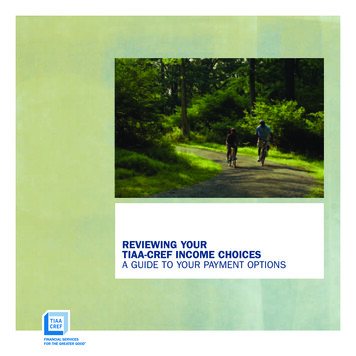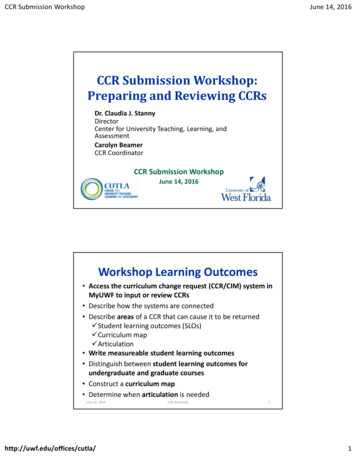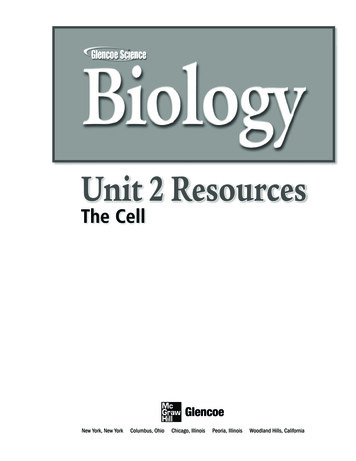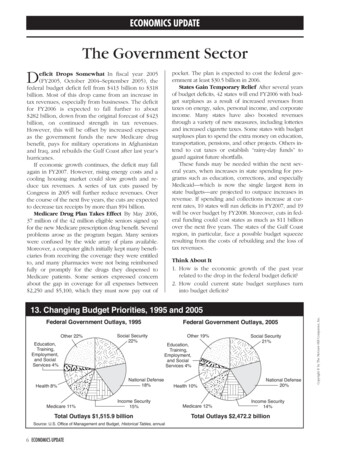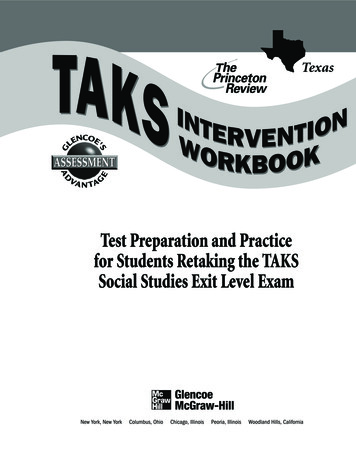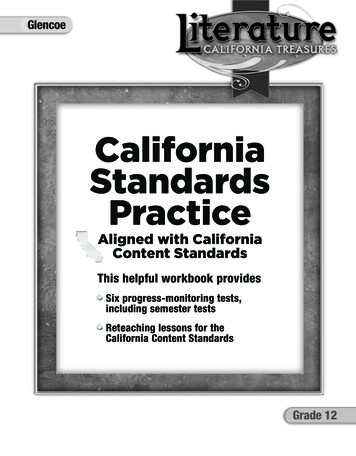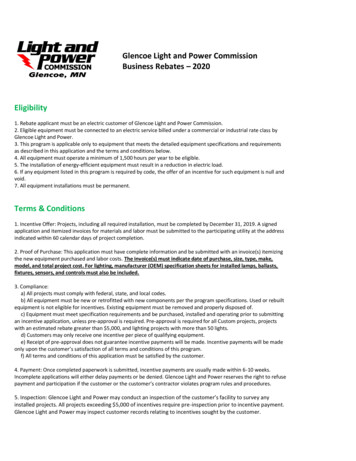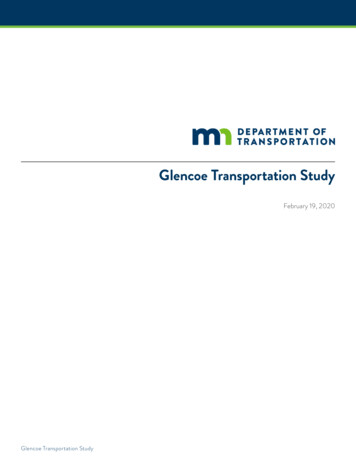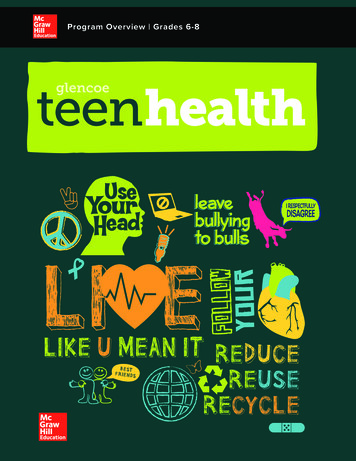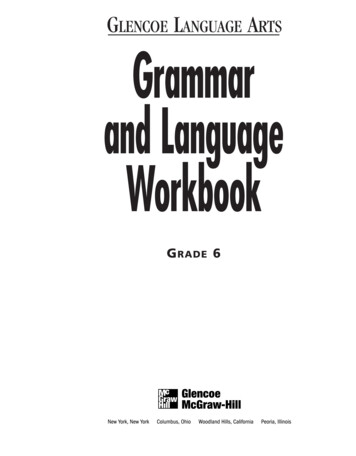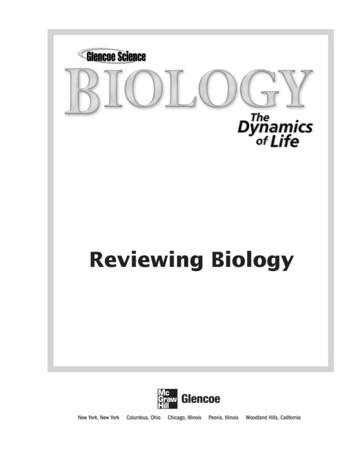
Transcription
Reviewing Biology
A GLENCOE PROGRAMBIOLOGY: THE DYNAMICS OF LIFEGlencoe OnlineSCIENCEVisit the Glencoe Science Web sitebdol.glencoe.comYou’ll find:Standardized Test Practice, InteractiveTutor, Section and Chapter Self-CheckQuizzes, Online Student Edition, WebLinks, Microscopy Links, WebQuestProjects, Internet BioLabs, In the News,Textbook Updates, Teacher BulletinBoard, Teaching Todayand much more!The review materials in this book were written by The Princeton Review, the nation’sleader in test preparation. Through its association with McGraw-Hill, The PrincetonReview offers the best way to help students excel on standardized assessments.The Princeton Review is not affiliated with Princeton University or Educational Testing Service.Copyright by The McGraw-Hill Companies, Inc. All rights reserved. Permission is granted toreproduce the material contained herein on the condition that such material be reproduced onlyfor classroom use; be provided to students, teachers, and families without charge; and be usedsolely in conjunction with the Biology: The Dynamics of Life program. Any other reproduction,for use or sale, is prohibited without prior written permission of the publisher.Send all inquiries to:Glencoe/McGraw-Hill8787 Orion PlaceColumbus, OH 43240ISBN 0-07-860230-0Printed in the United States of America.1 2 3 4 5 6 7 8 9 10 009 08 07 06 05 04 03
ContentsCopyright Glencoe/McGraw-Hill, a division of The McGraw-Hill Companies, Inc.TO THE TEACHER . . . . . . . . . . . . . . . . . . . . . . . . . . . . . . . . . . . . . . . . . . . . . . . . . . IVNATIONAL SCIENCE EDUCATION STANDARDS . . . . . . . . . . . . . . . . . . . . . . . . . . . . . . . . VCORRELATION TABLE . . . . . . . . . . . . . . . . . . . . . . . . . . . . . . . . . . . . . . . . . . . . . . . VICHAPTER 1CHAPTER 2CHAPTER 3CHAPTER 4CHAPTER 5CHAPTER 6CHAPTER 7CHAPTER 8CHAPTER 9CHAPTER 10CHAPTER 11CHAPTER 12CHAPTER 13CHAPTER 14CHAPTER 15CHAPTER 16CHAPTER 17CHAPTER 18CHAPTER 19CHAPTER 20CHAPTER 21CHAPTER 22CHAPTER 23CHAPTER 24CHAPTER 25CHAPTER 26CHAPTER 27CHAPTER 28CHAPTER 29CHAPTER 30CHAPTER 31CHAPTER 32CHAPTER 33CHAPTER 34CHAPTER 35CHAPTER 36CHAPTER 37CHAPTER 38CHAPTER 39BIOLOGY: THE STUDY OF LIFE . . . . . . . . . . . . . . . . . . . .PRINCIPLES OF ECOLOGY . . . . . . . . . . . . . . . . . . . . . . .COMMUNITIES AND BIOMES . . . . . . . . . . . . . . . . . . . . .POPULATION BIOLOGY . . . . . . . . . . . . . . . . . . . . . . . . .BIOLOGICAL DIVERSITY AND CONSERVATION . . . . . . . . . .THE CHEMISTRY OF LIFE . . . . . . . . . . . . . . . . . . . . . . . .A VIEW OF THE CELL . . . . . . . . . . . . . . . . . . . . . . . . . .CELLULAR TRANSPORT AND THE CELL CYCLE . . . . . . . . . .ENERGY IN A CELL . . . . . . . . . . . . . . . . . . . . . . . . . . .MENDEL AND MEIOSIS . . . . . . . . . . . . . . . . . . . . . . . .DNA AND GENES . . . . . . . . . . . . . . . . . . . . . . . . . . .PATTERNS OF HEREDITY AND HUMAN GENETICS . . . . . . . .GENETIC TECHNOLOGY . . . . . . . . . . . . . . . . . . . . . . . . .THE HISTORY OF LIFE. . . . . . . . . . . . . . . . . . . . . . . . . .THE THEORY OF EVOLUTION . . . . . . . . . . . . . . . . . . . . .PRIMATE EVOLUTION . . . . . . . . . . . . . . . . . . . . . . . . . .ORGANIZING LIFE’S DIVERSITY . . . . . . . . . . . . . . . . . . .VIRUSES AND BACTERIA . . . . . . . . . . . . . . . . . . . . . . . .PROTISTS . . . . . . . . . . . . . . . . . . . . . . . . . . . . . . . . . .FUNGI . . . . . . . . . . . . . . . . . . . . . . . . . . . . . . . . . . .WHAT IS A PLANT? . . . . . . . . . . . . . . . . . . . . . . . . . . .THE DIVERSITY OF PLANTS . . . . . . . . . . . . . . . . . . . . . .PLANT STRUCTURE AND FUNCTION . . . . . . . . . . . . . . . . .REPRODUCTION IN PLANTS . . . . . . . . . . . . . . . . . . . . . .WHAT IS AN ANIMAL? . . . . . . . . . . . . . . . . . . . . . . . . .SPONGES, CNIDARIANS, FLATWORMS, AND ROUNDWORMS .MOLLUSKS AND SEGMENTED WORMS . . . . . . . . . . . . . . .ARTHROPODS . . . . . . . . . . . . . . . . . . . . . . . . . . . . . . .ECHINODERMS AND INVERTEBRATE CHORDATES . . . . . . . . .FISHES AND AMPHIBIANS . . . . . . . . . . . . . . . . . . . . . . .REPTILES AND BIRDS . . . . . . . . . . . . . . . . . . . . . . . . . .MAMMALS . . . . . . . . . . . . . . . . . . . . . . . . . . . . . . . .ANIMAL BEHAVIOR . . . . . . . . . . . . . . . . . . . . . . . . . . .PROTECTION, SUPPORT, AND LOCOMOTION . . . . . . . . . . . .THE DIGESTIVE AND ENDOCRINE SYSTEMS . . . . . . . . . . . .THE NERVOUS SYSTEM . . . . . . . . . . . . . . . . . . . . . . . .RESPIRATION, CIRCULATION, AND EXCRETION . . . . . . . . . .REPRODUCTION AND DEVELOPMENT . . . . . . . . . . . . . . . .IMMUNITY FROM DISEASE . . . . . . . . . . . . . . . . . . . . . 5153555759616365676971737577ANSWER SHEET . . . . . . . . . . . . . . . . . . . . . . . . . . . . . . . . . . . . . . . . . . . . . . . . . . 79iii
To the TeacherCopyright Glencoe/McGraw-Hill, a division of The McGraw-Hill Companies, Inc.Reviewing Biology provides one page of multiple choice questions for each chapter ofBiology: The Dynamics of Life. The questions test students’ mastery of chapter concepts.Each page of questions is followed by an Answers and Explanations page containinganswers to the questions, explanations and feedback on the topic, and a text referencewhere additional information on the topic can be found. Students can use these pages as aself-check and guide for further study. Each question has been correlated to the NationalScience Education Standards. Those standards can be found at the end of each text reference on the Answers and Explanations page. A chart on pages vi-vii shows the completecorrelation. An optional answer key master can be found on page 79.iv
NATIONAL SCIENCE EDUCATION STANDARDSScience Content Standards for Grades 9–12The National Science Education Standards, published by the National Research Counciland representing the contributions of thousands of educators and scientists, offer a comprehensive vision of a scientifically literate society. The standards not only describe whatstudents should know but also offer guidelines for biology teaching and assessment.Correlations on each answer page in this booklet show the close alignment between thecontent standards and the review questions. Correlations are designated according to thenumbering system in the table of science content standards shown below.NATIONAL SCIENCE CONTENT STANDARDSCopyright Glencoe/McGraw-Hill, a division of The McGraw-Hill Companies, Inc.Unifying Concepts and ProcessesUCP.1 Systems, order, and organizationUCP.2 Evidence, models, andexplanationUCP.3 Change, constancy, andmeasurementUCP.4 Evolution and equilibriumUCP.5 Form and functionScience as InquiryA.1 Abilities necessary to do scientificinquiryA.2 Understandings about scientificinquiryPhysical ScienceB.1 Structure of atomsB.2 Structure and properties of matterB.3 Chemical reactionsB.4 Motions and forcesB.5 Conservation of energy andincrease in disorderB.6 Interactions of energy and matterLife ScienceC.1 The cellC.2 Molecular basis of heredityC.3 Biological evolutionC.4 Interdependence of organismsC.5 Matter, energy, and organization inliving systemsC.6 Behavior of organismsREVIEWING BIOLOGYEarth and Space SciencesD.1 Energy in the earth systemD.2 Geochemical cyclesD.3 Origin and evolution of the earthsystemD.4 Origin and evolution of the universeScience and TechnologyE.1 Abilities of technological designE.2 Understandings about science andtechnologyScience in Personal and SocialPerspectivesF.1 Personal and community healthF.2 Population growthF.3 Natural resourcesF.4 Environmental qualityF.5 Natural and human-induced hazardsF.6 Science and technology in local,national, and global challengesHistory and Nature of ScienceG.1 Science as a human endeavorG.2 Nature of scientific knowledgeG.3 Historical perspectivesNATIONAL SCIENCE EDUCATION STANDARDSv
Correlation of Reviewing Biology toNational Science Education Standards Grades 9–12Standard1 Biology: The Study of LifeUCP.1–UCP.4, A.1, A.2, B.2, C.4, C.5, E.1,G.1, G.22 Principles of EcologyUCP.1–UCP.3, A.2, B.1–B.3, C.1, C.4–C.6,D.2, G.23 Communities and BiomesUCP.1, UCP.3, UCP.5, A.2, B.3, C.1, C.4,C.5, F.4, G.24 Population BiologyUCP.1–UCP.4, C.4–C.6, F.2, F.4, G.25 Biological Diversity andConservationUCP.1, UCP.2, B.3, C.4, C.5, F.2–F.5, G.2,G.36 The Chemistry of LifeUCP.5, A.1, A.2, B.1–B.3, B.6, C.57 A View of the CellUCP.2, UCP.4, UCP.5, A.1, B.2, C.1, C.5,E.1, E.2, G.38 Cellular Transport and the CellCycleUCP.3–UCP.5, A.2, B.6, C.1, C.5, F.19 Energy in a CellUCP.5, B.2, B.3, B.6, C.1, C.5, G.210 Mendel and MeiosisUCP.2, C.1, C.2, F.1, G.2, G.311 DNA and GenesUCP.1, UCP.5, A.1, C.1, C.2, C.5, F.1, G.212 Patterns of Heredity and HumanGeneticsUCP.2, UCP.3, C.2, C.5, F.1, G.1, G.213 Genetic TechnologyUCP.2, C.2, E.1, E.2, G.1, G.214 The History of LifeUCP.2, UCP.3, B.2, C.1, C.3, C.5, D.3, E.2,G.1–G.315 The Theory of EvolutionUCP.2, UCP.4, UCP.5, C.3, C.4, F.2, G.316 Primate EvolutionUCP.1, UCP.2, UCP.4, UCP.5, A.2, C.3, C.6,E.2, G.2, G.317 Organizing Life’s DiversityUCP.1, UCP.2, UCP.4, A.1, A.2, C.1, C.3,C.5, C.6, G.1–G.318 Viruses and BacteriaUCP.5, C.1, C.2, C.6, F.1, F.4, G.219 ProtistsUCP.1, UCP.5, A.1, C.5, C.6, G.2viCORRELATION TABLEREVIEWING BIOLOGYCopyright Glencoe/McGraw-Hill, a division of The McGraw-Hill Companies, Inc.Chapter
Copyright Glencoe/McGraw-Hill, a division of The McGraw-Hill Companies, Inc.ChapterStandard20 FungiUCP.5, C.4–C.6, G.221 What Is a Plant?UCP.1, UCP.2, UCP.4, UCP.5, A.1, C.1, C.3,C.5, G.2, G.322 The Diversity of PlantsUCP.1, UCP.3, UCP.5, C.4–C.6, G.223 Plant Structure and FunctionUCP.5, A.1, C.1, C.5, C.6, G.224 Reproduction in PlantsUCP.3, UCP.5, C.5, C.6, G.225 What Is an Animal?UCP.1, UCP.3–UCP.5, A.1, A.2, C.3, C.5,G.326 Sponges, Cnidarians, Flatworms,and RoundwormsUCP.1, UCP.3, UCP.5, A.1, C.1, C.3, C.5,C.6, G.227 Mollusks and Segmented WormsUCP.1, UCP.5, A.2, C.4–C.6, F.3, G.228 ArthropodsUCP.1, UCP.3, UCP.5, C.5, C.6, G.229 Echinoderms and InvertebrateChordatesUCP.5, C.4–C.6, G.230 Fishes and AmphibiansUCP.1–UCP.3, UCP.5, A.1, C.3, C.5, C.631 Reptiles and BirdsUCP.2, UCP.4, UCP.5, C.3, C.5, C.6, G.2, G.332 MammalsUCP.3–UCP.5, A.1, C.3, C.5, C.6, G.2, G.333 Animal BehaviorUCP.1, UCP.3, C.5, C.6, G.234 Protection, Support, andLocomotionUCP.5, C.1, C.5, C.6, F.1, G.235 The Digestive and EndocrineSystemsUCP.1, UCP.5, B.3, C.1, C.5, F.136 The Nervous SystemUCP.1, UCP.3, UCP.5, C.1, C.5, F.1, F.537 Respiration, Circulation, andExcretionUCP.1, UCP.5, C.1, C.5, F.138 Reproduction and DevelopmentUCP.3, UCP.5, C.1, C.5, F.139 Immunity from DiseaseUCP.2, UCP.3, UCP.5, A.2, C.1, C.5, C.6,F.1, F.5, G.1–G.3REVIEWING BIOLOGYCORRELATION TABLEvii
Chapter 1Nameorganism is affected by interactions with1 Anwhich of the following?ABCDOther organisms of the same speciesOther organisms of different speciesThe natural environmentAll of the abovegroup of organisms that can interbreed and2 Aproducefertile offspring is called a(n) —ABCDfamily.species.organization.community.the human body, heat is constantly3 Insidegenerated as a byproduct of chemical reactions.Copyright Glencoe/McGraw-Hill, a division of The McGraw-Hill Companies, Inc.Humans must be able to release heat to theenvironment. This adaptation is necessary formaintaining —A energy.B organization.C homeostasis.D locomotion.DateClassof the following tools would you need to5 Whichcarry out the experiment in question 4?ABCDThermometerMetric balanceGraduated cylinderAll of the abovescientist performs a series of experiments to6 Aconfirman idea regarding cellular metabolism.The results of her experiments support herinitial idea, and after conferring with colleagues,she discovers that evidence from many experiments has supported the same idea. This ideanow can be considered a(n) —A theory.B hypothesis.C observation.D control.of the following procedures7 Whichconsidered a scientific method?ABCDisCollecting dataMaking a hypothesisObservingAll of the abovesimplify the results of an experiment, many8 ToSugar dissolves in, or mixes completely with,researchers hold all variables constant except4 water.The solubility of a substance in water isfor one. They then compare the results withdetermined by measuring the maximumamount of the substance that dissolves in agiven amount of water at a given temperature.Hypothesis: The solubility of sugar in waterincreases as the temperature of the waterdecreases. Identify the independent variableand the dependent variable that you would useto test this hypothesis.A Dependent variable—volume of water; independent variable—water temperatureB Dependent variable—water temperature;independent variable—amount of sugar thatdissolvesC Dependent variable—amount of sugar thatdissolves; independent variable—water temperatureD Dependent variable—amount of sugar thatdissolves; independent variable—mineralcontent of the waterREVIEWING BIOLOGYrespect to that one variable. This type ofexperiment is known as a —A variable experiment.B multi-factor experiment.C controlled experiment.D None of the aboveof the following units is part of the9 WhichInternational System of Measurement (SI)?ABCDPoundInchMeterGallonscientist uses graphs, tables, and charts tobk Apublishthe results of his research. What type ofresearch was he probably performing?A Descriptive researchB Quantitative researchC Qualitative researchD None of the aboveCHAPTER 11
Chapter 1Name1DClass6AOrganisms depend upon other living things aswell as nonliving things in the environment.More about interactions within nature can be found onpage 5 of this chapter. National Science EducationStandards C.4A theory is a hypothesis that has been supportedby extensive scientific research and evidence.More about scientific theories can be found on pages17–18 of this chapter. National Science EducationStandards UCP.2, G.27DA species is a group of organisms that can reproduce to create fertile offspring. More about thereproduction of living things can be found on page 7 of thischapter. National Science Education Standards C.53CHomeostasis is the regulation of an organism’sinternal environment to preserve conditionsconducive to life. Temperature regulation is oneform of homeostasis in human beings. More abouthomeostasis can be found on page 9 of this chapter.National Science Education Standards UCP. 4, C.54CThe dependent variable is the amount of sugarthat dissolves, and the independent variable iswater temperature. As you lower the temperatureof the water, more sugar should dissolve in thewater. More about identifying experimental variables can be found on pages 12–17 of this chapter.National Science Education Standards UCP.2, B.2, G.25DYou would need a thermometer to measurewater temperature, a balance to mass the sugar,and a graduated cylinder to measure the watervolume. More about the tools of science can befound on page 14 of this chapter. National ScienceEducation Standards UCP.3, E.1CHAPTER 1Scientific methods involve observing, developinghypotheses, collecting data, publishing results,and forming theories. More about scientific methodscan be found on pages 11–21 of this chapter. NationalScience Education Standards UCP.2, A.18CA controlled experiment is one in which a groupin which all conditions remain the same is compared to a group in which one variable has beenchanged. By comparing a controlled group andan experimental, or changed, group, the effect ofa changed variable can be determined. More aboutcontrolled experiments can be found on pages 13–14 ofthis chapter. National Science Education StandardsUCP.2, UCP.3, A.2, G.29CThe SI is a decimal system consisting of meters,grams, liters. seconds, and degrees Celsius. Moreabout the SI can be found on pages 20–21 of this chapter. National Science Education Standards UCP.1,UCP.3, A.2bk BQuantitative research results in numerical datathat can be displayed easily as charts, graphs, andtables. More about types of research can be found onpages 15 and 19 of this chapter. National ScienceEducation Standards UCP.2, UCP.3, G.1REVIEWING BIOLOGYCopyright Glencoe/McGraw-Hill, a division of The McGraw-Hill Companies, Inc.2B2Date
Chapter 2NameDate1 Ecology is the study of relationships among —ABCDliving things only.living and nonliving things.nonliving things only.None of the aboveportion of Earth that supports2 Theexistence of living things is called the —ABCDecosystem.habitat.biosphere.niche.of the following is a biotic factor that3 Whichmight affect the life of a water-dwellingorganism?A Temperature of the waterB Speed of water currentC Pollutants in waterD Bacterial population in waterCopyright Glencoe/McGraw-Hill, a division of The McGraw-Hill Companies, Inc.EcosystemCommunityPopulationDivisionof the following has NOT5 Whichdescribed as a major kind of IEWING BIOLOGYlinks long?A Pyramid of biomassB Pyramid of energyC Pyramid of numbersD None of the abovedoes the amount of water on Earth change8 Howas a result of the water cycle?It always increasesIt alternately increases and decreasesIt remains constantIt always decreasesthe carbon cycle, in what form are carbon9 Inatoms generally returned to the atmosphere?ABCDbeenFirst-order heterotrophsThird-order heterotrophsProducersNone of the aboveecological pyramid best explains why7 Whichfood chains are typically only three or fourABCDlevel of organization encompasses all of4 Whichthe others?ABCDof the following is NOT consumed by6 Whichfungal decomposers?ABCDtheClassSimple sugarsCarbon monoxideMethaneCarbon dioxideof the following things does NOT allowbk Whichplants to obtain atmospheric nitrogen in amore usable form?A PhotosynthesisB LightningC Symbiotic bacteriaD Chemical fertilizersCHAPTER 23
Chapter 2Name6DEcology is defined as the study of interactionsamong organisms and their environments. Moreabout the study of ecology can be found on pages 35–36of this chapter. National Science Education StandardsC.4, G.22CThe biosphere spans the region between theupper atmosphere and the bottom of the ocean.Within this region, living things can exist; outside the biosphere, conditions are not conduciveto life. More about the biosphere can be found on page36 of this chapter. National Science Education StandardsUCP.1, C.5, G.23DBiotic factors include all the living organismsthat inhabit an environment. Bacteria are livingorganisms and are considered biotic factors. Moreabout biotic and abiotic factors can be found on pages37–41 of this chapter. National Science EducationStandards C.44AThe highest level of organization within thebiosphere is the ecosystem. An ecosystem consists of the interactions between a communityand its abiotic surroundings. More about the levelsof ecological organization can be found on pages 38–40of this chapter. National Science Education StandardsUCP.1, C.4, C.5, G.25BBacteria and fungi are capable of decomposingall organisms after they die. Therefore, all trophic levels of organisms are consumed by decomposers. More about how organisms obtain energy canbe found on pages 47–50 of this chapter. NationalScience Education Standards A.2, B.3, C.67BPyramids of energy illustrate that the energycontained in each trophic level decreases astrophic level increases. After three or four links,little energy remains in the pyramid. More aboutecological pyramids can be found on pages 48–53 of thischapter. National Science Education Standards UCP.2,A.2, B.2, C.58CThe water cycle describes the recycling of watermolecules. Water is neither created nor destroyedin the cycle. Thus, the amount of water remainsconstant throughout the cycle. More about thewater cycle can be found on pages 53–54 of this chapter.National Science Education Standards UCP.3, B.1, D.29DCarbon is generally returned to the atmospherein the form of carbon dioxide. For example, carbon dioxide is released when organisms exhaleand when fossil fuels are burned. More about thecarbon cycle can be found on pages 54–55 of this chapter. National Science Education Standards A.2, B.1, D.2bk AThree major types of ecosystems are terrestrial,freshwater, and salt water or marine. More aboutecosystems can be found on page 41 of this chapter.National Science Education Standards UCP.1, A.2, C.54ClassCHAPTER 2Nitrogen is converted to more usable forms bylightning and by bacteria. In addition, chemicalfertilizers are composed of usable nitrogen. Moreabout the nitrogen cycle can be found on page 56 of thischapter. National Science Education Standards A.2, B.1,C.1, D.2REVIEWING BIOLOGYCopyright Glencoe/McGraw-Hill, a division of The McGraw-Hill Companies, Inc.1BDate
Chapter 3NameDateClassof the following might be a limitingaquatic biomes, there are many1 Which6 Withinfactor in an organism’s survival?different environments where different types ofABCDTemperatureFood availabilityAbundance of predatorsAll of the abovebacteria are able to thrive in extremely2 Certainacidic environments where most organismscould not survive. This is an example ofdifferent organisms having different —A tolerances.B biotic factors.C abiotic factors.D None of the aboveof the3 Whichsuccession?Copyright Glencoe/McGraw-Hill, a division of The McGraw-Hill Companies, Inc.ABCDfollowing is NOT true ofIt is predictable.It is gradual.It is orderly.It is random.many plants can inhabit a rocky area,4 Beforesoil must be present. A pioneer species muststart the process of soil formation forsuccession to take place. Which of thefollowing would be a pioneer species in a rockyarea?A InsectB LichenC WeedD Fern5After a community is disrupted by large-scaleevents, such as forest fires, a new community isestablished through the process of —A primary succession.B secondary succession.C soil formation.D None of the aboveREVIEWING BIOLOGYorganisms thrive. In general, aquatic biomesare divided into photic and aphotic zones.Which of the following determines whether azone is photic or aphotic?A Distance from landB Distance from equatorC Water depthD All of the abovebiomes are classified based on the7 Terrestrialtypes of organisms that develop within them.The organisms that make up a biome share thesame type of —A biosphere.B ecosystem.C pioneer community.D climax community.8 Permafrost is characteristic of which biome?ABCDTundraMarineDesertTaigaterrestrial9 Whichbiodiversity?ABCDbiome houses the greatestTaigaTemperate forestTropical rain forestGrasslandorganisms that live in the photic zone ofbk Smallaquatic biomes are ic.CHAPTER 35
Chapter 3Name1DClass6CA limiting factor is anything, biotic or abiotic,that restricts an organism’s ability to survive inits environment. More about limiting factors can befound on page 65–66 of this chapter. National ScienceEducation Standards C.4, G.22AOrganisms demonstrate a wide range of tolerance for different environmental conditions. Theability of certain bacteria to withstand extremelyacidic conditions illustrates their tolerance forpH fluctuations. More about tolerance can be foundon page 66 of this chapter. National Science EducationStandards A.2, C.1, C.53DSuccession is a highly ordered, predictableprocess of species replacement. Though it cantake a great deal of time to occur, the order inwhich succession takes place is well understoodby scientists. More about succession can be found onpages 67–69 of this chapter. National Science EducationStandards UCP.1, UCP.3, C.4, G.2Photic and aphotic zones are defined by the ability of sunlight to penetrate an area. The deeperthe water, the less likely that sunlight will penetrate it. More about marine biomes can be found onpages 71–74 of this chapter. National Science EducationStandards B.3, C.5, G.27DTerrestrial biomes are classified by the type ofclimax community that is established under different environmental conditions, such as temperature and precipitation. More about various terrestrial biomes can be found on pages 74–83 of thischapter. National Science Education Standards UCP.1,A.2, C.5, D.18AIn the tundra, only the topmost layer of soilthaws in the summer. Underneath this soil is alayer of permanently frozen ground. This iscalled permafrost. More about the tundra can befound on pages 75–77 of this chapter. National ScienceEducation Standards UCP.5, C.1, C.5, G.29CThe first species to inhabit a given area is called apioneer species. Lichens inhabit rocky areas andwhen they die, their decaying bodies initiate thefirst patches of soil. More about pioneer species can befound on pages 67–69 of this chapter. National ScienceEducation Standards UCP.1, C.5, G.25BBecause of the unique combination of conditions present in the tropical rain forest, thisbiome offers more biodiversity than any other.More about tropical rain forests and biodiversity can befound on pages 81–83 of this chapter. National ScienceEducation Standards UCP.1, C.4, C.5, G.2bk ASecondary succession describes the process ofsuccession on land that already has soil and waspreviously inhabited. More about secondary succession can be found on pages 68–69 of this chapter.National Science Education Standards UCP.1, UCP.5,F.4CHAPTER 3Plankton are the primary organisms present inaquatic biomes. They live in the photic zone andinclude both autotrophs and heterotrophs. Moreabout plankton can be found on page 73–74 of this chapter. National Science Education Standards UCP.5, B.3,C.5, G.2REVIEWING BIOLOGYCopyright Glencoe/McGraw-Hill, a division of The McGraw-Hill Companies, Inc.4B6Date
Chapter 4NameDateClasspopulation growth can be illustratedpopulation1 Initially,6 Increasedas a J-shaped curve. What is this type of growthevents that reducecalled?A SinusoidalB LinearC ExponentialD None of the abovenew species of mouse is introduced into an2 Aenvironment.These mice reproduce and thepopulation grows. As the population grows, foodresources diminish and predation by hawksincreases. Eventually, the number of mice in theenvironment levels off so that the rate of birthequals the rate of death. What is this nearly constant number of organisms called?A Carrying capacityB Exponential growthC Linear growthD None of the aboveCopyright Glencoe/McGraw-Hill, a division of The McGraw-Hill Companies, Inc.after the situation in question 2 is reached,3 If,scientists introduce 100 new mice from thesame species into the environment, which ofthe following is most likely to occur in thepopulation of mice?A Death rate will decrease.B Death rate will increase.C Exponential growthD Linear growth4You are studying organisms in an artificialenvironment. The environment is constantlychanging and is unpredictable. What life-historypattern would you expect to be most commonin this environment?A Rapid reproduction and short life spanB Rapid reproduction and long life spanC Slow reproduction and short life spanD Slow reproduction and long life spanof the following limiting factors is NOT5 onFood supplyREVIEWING BIOLOGYdensity often leads tothe population size.Individual organisms often exhibit symptomsof stress in this situation. These symptomsinclude —A increased aggression.B increased infertility.C increased susceptibility to disease.D All of the aboveof the following7 Whichdemographers?ABCDis NOT studied byGrowth rateAge structureGeographic distributionNone of the aboveanalyzing the age structure of a population,8 Inyou discover that an extraordinarily highpercentage of the population is younger thanthe age of reproductive maturity. What kind ofgrowth will the population probablyexperience in the future?A Growth rate will remain the same.B Slow, steady growth increaseC Rapid growthD None of the abovefluctuations above and below the9 Drasticcarrying capacity are most likely to be seen in apopulation demonstrating which of thefollowing life-history patterns?A Slow growthB Population independentC Rapid growthD The pattern cannot be determined by theinformation given.are forest fires, temperature fluctuations,bk Whatand floods all examples of?ABCDBiotic, density-dependent factorsBiotic, density-independent factorsAbiotic, density-dependent factorsAbiotic, density-independent factorsCHAPTER 47
Chapter 4Name1CClass6DA J-shaped curve is indicative of exponentialgrowth. It is characteristic of the initial growth ofa population. More about the rate of population growthcan be found on pages 92–93 of this chapter. NationalScience Education Standards UCP.1, UCP.3, C.4, G.22ACarrying capacity is defined as the size of thepopulation of organisms of one species that canbe supported by the environment. The miceestablish an equilibrium around this number ofindividuals. More about carrying capacity can befound on pages 93–94 of this chapter. National ScienceEducation Standards UCP.3, C.4, F.2Stress for many organisms is characterized byincreased aggression, decreased parental care,decreased fertility, and decreased resistance todisease. More about the effects of crowding on populations can be found on page 99 of this chapter. NationalScience Education Standards C.6, F.27DDemography is the study of population growthcharacteristics, including growth rate, age structure, and geographic distribution. More aboutdemography can be found on page 100 of this chapter.National Science Education Standards UCP.3, F.28CWhen the population exceeds the carryingcapacity, death rate will increase until the population size decreases enough to be supported bythe environment. More about the limits of an
A GLENCOE PROGRAM BIOLOGY: THE DYNAMICS OF LIFE Glencoe Online SCIENCE Visit the Glencoe Science Web site bdol.glencoe.com You’ll find: Standardized Test Practice, Interactive Tutor, Section and Chapter Self-Check Quizzes, Online Student Edition, Web Links, Microscopy Links, WebQuest Proj
